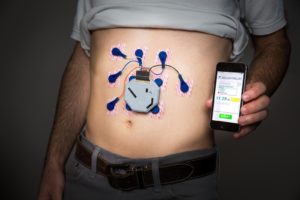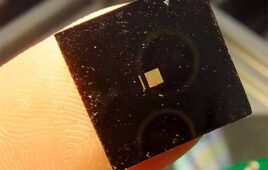
[Image from University of California at San Diego]
The system is a wearable, non-invasive system that provides GI activity monitoring outside of clinical settings while increasing the chance of identifying abnormal activity. It is a 3D printed portable box that is connected to 10 small wearable electrodes.
Researchers at the University of California at San Diego tested their device on 11 children and an adult volunteer. The data collected from the wearable was compared to data from clinical state-of-the-art methods that are usually invasive and can include a catheter being inserted through a patient’s nose. Using the data, the researchers also discovered that not only does the electrical activity in the stomach changes throughout the day and around meals, but it also follows its own circadian rhythm during sleep.
“We think our system will spark a new kind of medicine, where a gastroenterologist can quickly see where and when a part of the GI tract is showing abnormal rhythms and as a result, make more accurate, faster and personalized diagnoses,” Armen Gharibans, the study’s first author and bioengineering postdoctoral researchers at the UCSD, said in a press release.
The researchers suggest that the system could help meet a clinical need that has previously been difficult to achieve.
“This will help us determine if the stomach is functioning properly during meals and, most importantly, when patients are experiencing symptoms such as nausea and belly pain,” said David Kunkel, the study’s co-author and gastroenterologist.
One of the biggest challenges that the researchers had to overcome was designing algorithms that could recognize and boost electrical signals coming from the stomach, despite other noise and artifacts. Electrical signals from the stomach are 10 times weaker than those coming from the heart, which makes them harder to capture and analyze.
The device features off-the-shelf electrodes that are use in electrocardiograms, while the electronics and battery that powers the device is enclosed in a 3D printed box that is connected to the electrodes. The entire system fits on a person’s abdomen just over the stomach.
UC San Diego researchers tested the device on 11 pediatric patients at Rady Children’s Hospital in San Diego who were going through an invasive procedure called manometry which is one of the more invasive methods for monitoring GT tract activity. Comparing the device to manometry, the researchers found that the wearable provided reliable data.
“I have been practicing pediatric gastroenterology and taking care of patients for 20 years,” Hayat Mousa, a pediatrician at UC San Diego and Rady Children’s Hospital, said. “The only method to assess gastrointestinal motility involves placing motility catheters in the GI tracts while kids are sedated or under general anesthesia. It has been a long journey discussing the benefits of doing such an invasive procedure with my patients and their families. My challenge has always been finding a test that offers a non-invasive assessment of the enteric nervous system and its connection with brain function.”
The system uses a smartphone app that has patients log their meals, sleep and other activities. The researchers say that their goal is to design an app that lets patients and physicians see data from the device in real-time.
“The technique outlined in this paper is the best way to evaluate children with motility and functional GI disorders,” Mousa said. “It provides the information without need for sedation and it offers the flexibility to monitor kids while they continue their daily activities. This procedure allows convenience without compromising accuracy. In addition, it offers the option to assess the brain-gut response to therapeutic interventions including biofeedback and neuromodulation.”
Common GI problems like delayed emptying of the stomach can be monitored and managed easier with the system. Healthy people can also benefit from the system by using it to determine when the best time for meals is. Pregnant women and the elderly can also use it to monitor stomach activity before, during and after meals if they are susceptible to heartburn and other GI problems.
The research was published in the journal Scientific Reports and was funded by Larry Smarr who is a UC San Diego professor in the Department of Computer Science and Engineering and is the founding director of the California Institute for Telecommunications and Information Technology.




